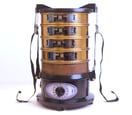An Introduction
Particle size analysis is the process of measuring and interpreting the distribution of particle sizes in a sample. It can be used to understand aspects of a material's physical properties such as flowability, dispersibility, sintering behavior and surface characteristics.
IImage Analysis is one technique for particle size analysis which uses digital cameras or microscopes to determine the  size and shape of particles within a sample.are taken and analyzed using specialized software to generate particle size distributions. This method can be used for particles ranging from around 5 µm up to several millimeters in diameter.
size and shape of particles within a sample.are taken and analyzed using specialized software to generate particle size distributions. This method can be used for particles ranging from around 5 µm up to several millimeters in diameter.
Laser Diffraction is another common technique used for particle size determination.  It works by scattering light through a sample containing particles in suspension and calculates the size distribution of the sample based on the angles and intensity of light scattered by individual particles. This method is most effective for particles between 10 µm and 2 mm in diameter.
It works by scattering light through a sample containing particles in suspension and calculates the size distribution of the sample based on the angles and intensity of light scattered by individual particles. This method is most effective for particles between 10 µm and 2 mm in diameter.
Sedimentation is a technique used to measure particle size distributions when dealing with particulates suspended in a liquid medium. Particles settle at different rates depending on their density and size, allowing for measurements of the various sizes present within a sample. This method works best for particles measuring from 1 µm up to several millimeters in diameter.
Sieving is an offline method that uses test sieves to separate granules into particle size classes prior to further analysis.Sieving is a mechanical technique used to separate particles of different sizes.  It relies on sieves of various mesh sizes which act as filters to trap particles within a certain size range. Sieving is primarily used for particle sizes ranging from 1 mm down to around 25 microns.
It relies on sieves of various mesh sizes which act as filters to trap particles within a certain size range. Sieving is primarily used for particle sizes ranging from 1 mm down to around 25 microns.
Sieving has many advantages compared to other particle size analysis techniques. It is relatively inexpensive, fast and easy to use, and requires minimal skill or experience to do correctly. Additionally, sieves can be used with a wide range of materials such as powders, granules, fibers, and pastes. As a result, sieving is the most commonly used technique for particle size analysis and is often employed as the starting point in a complete particle size determination process.
Sieves are the basic component of the sieve testing process. Sieve Shakers are the mechanical component that facilitate the separation by size. The parameters are defined by standards organizations such as ASTM and ISO.
Sieves consist of a frame, usually round, that holds media consisting openings of a specified size.  This media can be woven wire mesh, perforated plate or electroformed. The wire mesh, the most used, are made in reference to standardize tolerance levels.
This media can be woven wire mesh, perforated plate or electroformed. The wire mesh, the most used, are made in reference to standardize tolerance levels.
 can be categorized as follows:
can be categorized as follows:Quality control in the process of sieve testing depends on the reproducibility of results from one sieve to another. Several standards and practices have been developed to deal with this issue by organization such as ASTM and ISO.
Sieve certification is derived from standards such as AASTM E11 which defines the process of sieving, sieve construction and mesh tolerances. A sieve certification states that the individual sieve conforms to the construction standards and established tolerances.
The basic standard is the certification of a Compliance Sieve. The next two levels are Inspection and Calibration certifications.
There is also a special category known as a Mid-point Sieve. A sieve is selected as a mid-point if measurements fall in the middle of the ASTM standard. Mid -point sieves are used in master stacks and in sieving processes where reproducibility from one sieve to another is critical.
Sieve Certification defines levels of sieve measurements and acceptable tolerances in sieve openings. Certification references these measurements but does not directly relate to the actual performance of a sieve. Calibration is a dynamic process that predicts the performance of a sieve and relates that to consequences of orverall variances in sieve openings.
Calibration is done by loading calibrated micro spheres on a sieve and applying a shaking process. The result is an evaluation of the actual performance of the sieve.
Three are number of accessories that are helpful in conducting sieving operations.
Select Videos
We are here to help you.
We can answer your questions via Email, Phone call, Zoom meeting or chat.
We just need to know how best to serve you.
Let us know who you are, what you need and how you'd like to communicate.
Go to:
© 2023 CSC Scientific Company, Inc. All rights reserved.